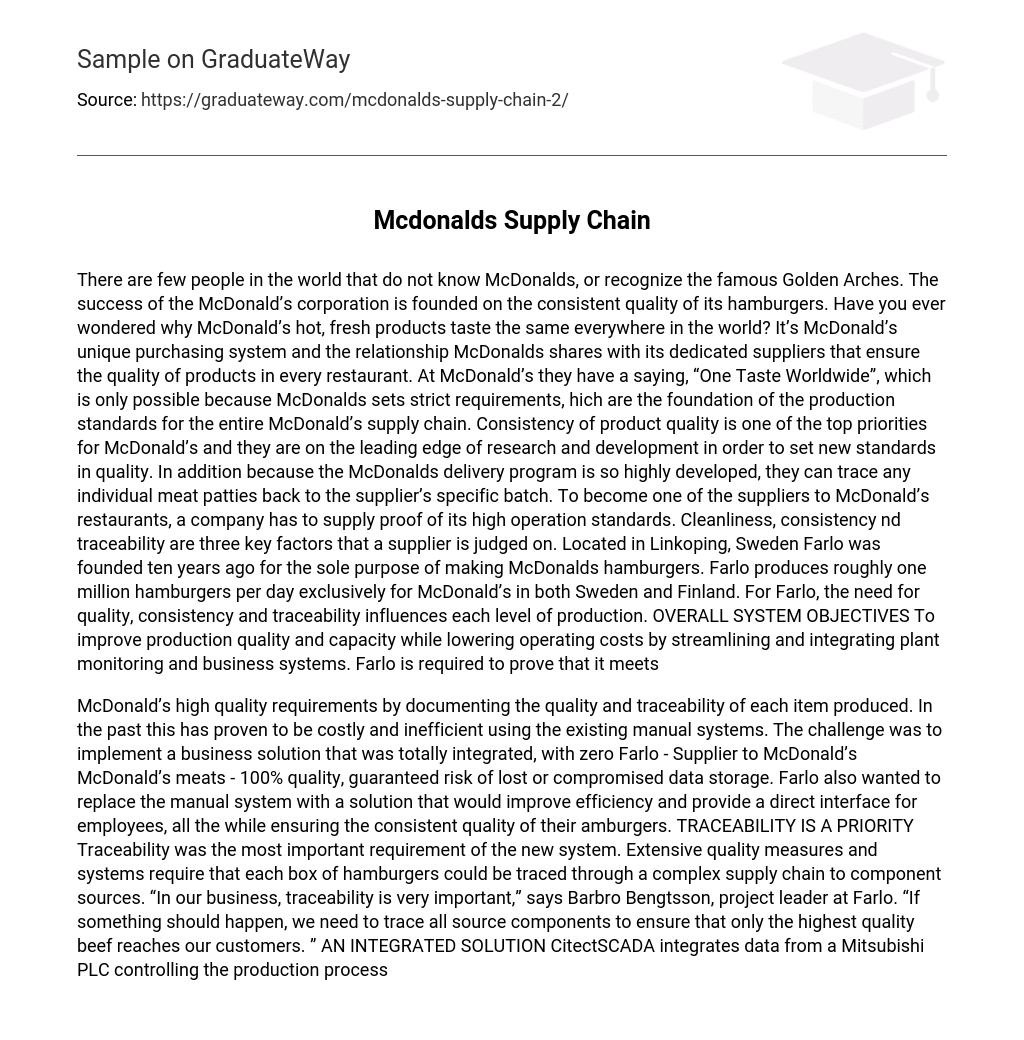McDonald’s is a globally recognized brand, known for its famous Golden Arches. The reason behind the consistent taste of McDonald’s products worldwide lies in their unique purchasing system and strong relationships with dedicated suppliers. McDonald’s adheres to strict requirements, ensuring high production standards throughout their supply chain to achieve their motto of “One Taste Worldwide.” They prioritize product quality and continuously drive research and development to set new standards. Notably, their advanced delivery program allows them to trace meat patties back to specific supplier batches. To become a McDonald’s supplier, companies must demonstrate high operational standards, focusing on cleanliness, consistency, and traceability. Farlo, located in Linkoping, Sweden, was established solely to produce McDonald’s hamburgers. This company produces approximately one million hamburgers per day exclusively for McDonald’s in Sweden and Finland.the standards for quality, consistency, and traceability across all levels of production. The overall goal is to enhance production quality and capacity, reduce operating costs, and achieve efficiency by integrating and streamlining plant monitoring and business systems. Farlo must provide evidence of meeting these standards.
McDonald’s has a need to meet high quality requirements for their products. Previously, this was done manually, which proved to be expensive and inefficient. The challenge was to find a business solution that was fully integrated and had no risk of data loss. Farlo, a supplier to McDonald’s for meats, wanted to replace the manual system with a more efficient solution that also provided an interface for employees. The new system needed to prioritize traceability, allowing each box of hamburgers to be traced back to its component sources. Barbro Bengtsson, project leader at Farlo, emphasized the importance of traceability in their business, as it ensures that only the highest quality beef is delivered to customers. A solution was found in CitectSCADA, which integrates data from a Mitsubishi PLC that controls the production process.
Jeeves Manufacturing Execution System (MES) was implemented alongside CitectSCADA, a solution presented by Elcontrol AB, a Swedish Citect Integration Partner. CitectSCADA was chosen for its ability to update to the latest version without impacting production or quality. Additionally, it was user-friendly and all necessary features could be integrated within the package. Both CitectSCADA and MES operate within the same network-domain and coexist on multiple workstations. Farlo successfully linked the production process to the administration system in a new way. The compatibility between the two systems and their suppliers has been seamless. The data acquisition rates from controllers and transfers to MES occur in less than 1 second, providing real-time data to the enterprise. CitectSCADA communicates using stored procedures, ensuring the integrity of the MES database. The CitectSCADA Server allows other applications to trigger events through standardized interfaces. When an event is triggered, CitectSCADA captures a snapshot of process data and logs it to the MES database.Farlo has achieved the highest level of traceability among all McDonald’s suppliers worldwide by using CitectSCADA to connect production processes to the administration system. As a result, McDonald’s is planning to implement similar systems in other plants. CitectSCADA monitors production machines and plant temperatures, while the MES is responsible for stock overview, traceability, fat content registration, and pre-blend recipe. Production machine monitoring includes meat mixing, hamburger patty formation, final mixture recipe monitoring, and sending batch information to the MES for traceability. Farlo orders meat through the MES, which is automatically transferred to CitectSCADA for the grinding operator’s complete overview of available raw materials. McDonald’s requires two types of mince with different fat content, both of which should deviate by less than one percent. CitectSCADA automatically allocates the amount of fat and lean minced meats and calculates the correct blend ratio based on required fat content values. The two minces are combined to create a mix with the desired fat content, which is then molded into 45 gram and 113 gram hamburger patties through one of two production lines at Farlo.CitectSCADA is used to supervise the mixing process and transfer batch results, like fat content and quantity, to the MES. It also optimizes, executes, and reports these results for each batch. Fat data is manually entered into the MES and sent to CitectSCADA for analysis through its Statistical Process Control algorithms. The operator performs random size and weight checks on the patties, entering the data into CitectSCADA. This system updates the MES with batch start and stop times, batch number, and production time and date information. Each box of patties is marked with the batch’s time and date to track them until they reach the customer’s bun, providing traceability. The integration between CitectSCADA and the MES allows for a smooth operation as a single system. Farlo employees have direct access to both systems, giving them more information and control in their work. This integrated approach increases efficiency and reliability in their daily work. Barbro Bengtsson states that this holistic approach improves their daily work process.CitectSCADA has automated various manual operations at the plant, leading to enhanced quality by eliminating human errors and reducing delays in business information systems. It has also greatly improved production performance. Graphs can be found below on the left, while a diagram of the Farlo system is on the right. The CitectSCADA version used is 5.20, operating system is WinNT4.0 Server &WS, and the network equipment consists of a TCP/IP network primarily utilizing 3COM hardware. The number of CitectSCADA tags is 500, with 50 digital alarms and 40 trends.
Number of CitectSCADA graphics pages: 15
Number of CitectSCADA IO, Trend and Alarm Servers: 1
Number of Windows NT File Servers: 1
Number of Windows SQL File Servers (Dual Pentium 200, 128MB RAM): 1 cluster (768 MB RAM)
Number of CitectSCADA Display Nodes: 11
Number of I/O Devices: 1
Observed response time: 0.035 sec
Observed time to call up a graphics page (with all display data): < 0.5 sec
Observed time to call up an historical trend page (with all display data): < 1 sec
IO, Trend, Alarm and Report Server CPU Usage: 5%
Statistics ABOVE: Packing the McDonald’s hamburgers





